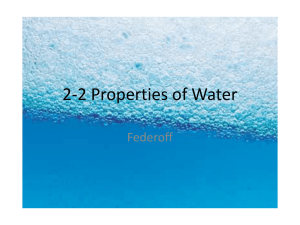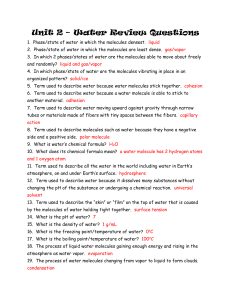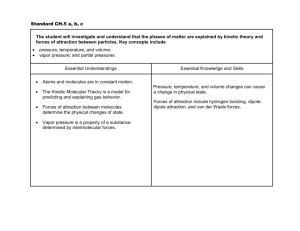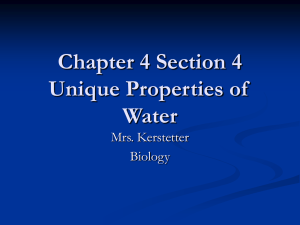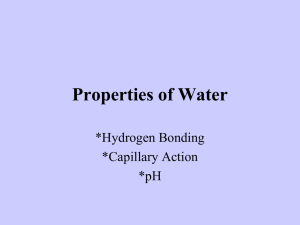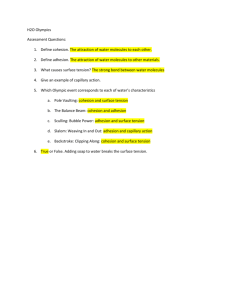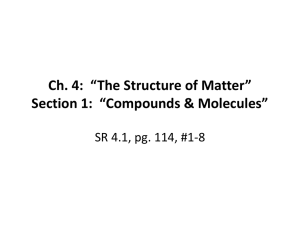Properties of Water Notes
advertisement
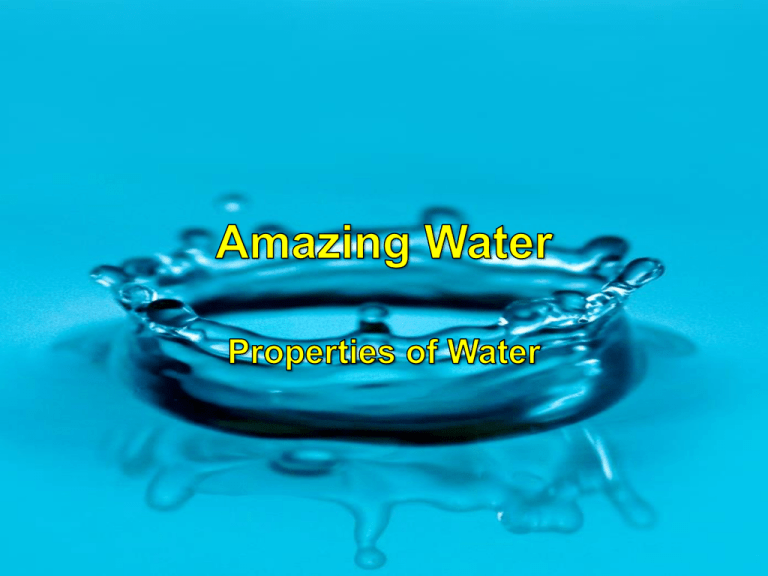
A water molecule (H2O)consist of 3 atoms: 2 atoms and 1 atom. H H Water molecules have a slightly negative (-) charge near the oxygen atom and a slightly positive (+) charge near the hydrogen atoms. This uneven distribution of charges across the water molecule makes it . The opposite poles of the water molecule attract each other and stick together. This property allows water to have so many unique properties! Water molecules act like a “magnet” Water is attracted to itself! happens when a force of attraction acts on the molecules at the surface of a liquid. Each water molecule is pulled in all directions by other molecules. The attractive forces are pulling downward and sideways causing the molecules at the surface to be held more tightly together forming a “skin” at the surface. is the tendency of water to stick to other substances. Think of it this way... Adhesion is an attraction between two different substances. Meniscus Adhesion causes a meniscus • Water sticks to the sides of the glass Concave and Convex • A – concave • B – convex Cohesive Properties • Water sticks to water causing big droplets to ‘bead’ up Adhesive Properties • The formula reduces the ability of adhesion, causing the water to quickly slide off windshield is the measure of mass per unit volume of a substance. = m/v changes with temperature. Cold water is denser than warm water. If combined, the cold water would sink to the bottom of the warm water. will change with physical state of matter. Ice is less dense than water. That means ice will float in water because ice expands when it freezes causing it to have a greater volume. •Water has a of 1 g/mL. is the ability of a fluid to exert an upward force on an object that is immersed in the fluid. In other words… is the ability for an object to float in a fluid! •All liquids exert an upward force, called buoyant force. If the buoyant force on an object is greater than the downward force (gravitational force), the object will float. So based on buoyant force, how does a submarine work? USS Sealey is the amount of energy that is needed to raise 1 gram of a substance by 1 °C. Water has a high (4.184 J/kg∙°C ). This is due to the strong attraction among water molecules. What does this mean? Water takes a long time to heat up and to cool down. Water resists temperature change. This property enables lakes, streams, and ocean ecosystems to maintain a stable temperature, even if the air temperature surrounding the body of water changes drastically. is the combined forces of attraction among water molecules and the molecules of surrounding materials. Water molecules will “tow” each other along while in a tube. This property allows : •water to move through materials with pores inside •causes water molecules to cling to fibers in materials such as paper and cloth • water to rise in a straw/tube. Water is the . Water dissolves more substances than any other known substance. A solvent is the substance in which another substance (solute) dissolves. Water’s polarity is the reason why water is such a good solvent. WHY? Water attracts and bonds with the ions in compounds. As you can see in the diagram, water molecules attract and forms bonds with the Na+ and Cl- ions in a crystal of salt. As the water pulls these ions into solution, the salt crystals dissolves.


